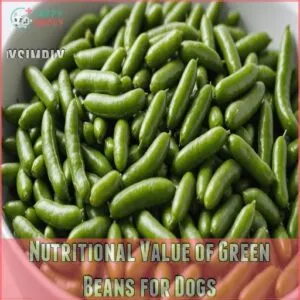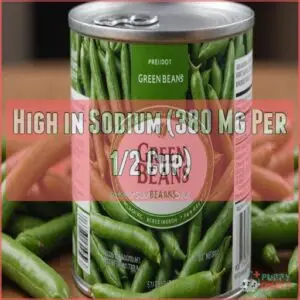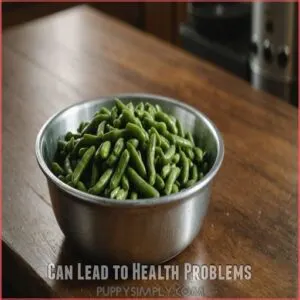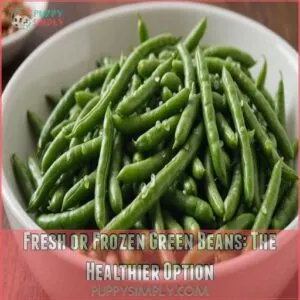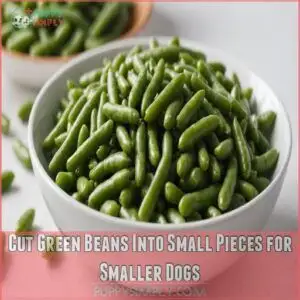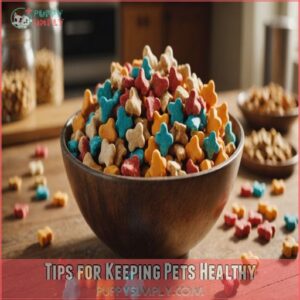This site is supported by our readers. We may earn a commission, at no cost to you, if you purchase through links.

While these veggies are packed with fiber and vitamins, canned versions can pack a sodium punch – about 380mg per half cup!
You’re better off rinsing them first (this cuts sodium by 41%) or choosing fresh or frozen alternatives.
Stick to plain beans without added salt, butter, or seasonings.
For portion control, think small: a couple of pieces for tiny pups, up to a handful for larger breeds.
Just like humans watching their salt intake, your furry friend will benefit from making informed choices about their green bean treats.
Table Of Contents
- Key Takeaways
- Nutritional Value of Green Beans for Dogs
- Canned Green Beans and Sodium Concerns
- Fresh or Frozen Green Beans: The Healthier Option
- Preparing Green Beans for Dogs
- Feeding Guidelines for Green Beans
- Types of Green Beans
- Green Bean Diet for Dogs: Not Recommended
- Health Concerns With Green Beans
- Tips for Keeping Pets Healthy
- Frequently Asked Questions (FAQs)
- How many canned green beans can I give my dog?
- Are canned vegetables ok for dogs?
- Why can’t dogs eat canned beans?
- How to prepare canned green beans for dogs?
- How long do cooked green beans last for dogs?
- Can puppies under 6 months eat green beans?
- Are green bean plants toxic to dogs?
- Do green beans help with dog allergies?
- Can diabetic dogs safely eat green beans regularly?
- Conclusion
Key Takeaways
- You can feed your dog canned green beans, but you’ll need to rinse them first to reduce sodium content by 41% – they contain about 380mg of sodium per half cup.
- You’re better off choosing fresh or frozen green beans instead of canned ones, as they don’t contain added sodium and provide the same nutritional benefits.
- You should limit green beans to 10% of your dog’s daily diet and adjust portions by size: 1-2 pieces for extra-small dogs, up to a large handful for extra-large breeds.
- You shouldn’t replace your dog’s regular food with green beans – while they’re healthy treats rich in vitamins C, K, and A, they lack essential nutrients needed for a balanced diet.
Nutritional Value of Green Beans for Dogs
Green beans pack a nutritious punch for your pup, being rich in vitamins C, K, and A, low in calories, and full of fiber.
They help with weight management and can even make a crunchy treat—though we can’t promise Fido won’t ask for seconds!
Rich in Vitamins C, K, and A
Imagine boosting your pup’s health with a handful of crunchy green beans.
These little green wonders are packed with:
- Vitamin C: Helps boost the immune system.
- Vitamin K: Supports strong bones.
- Vitamin A: Keeps eyes gleaming.
It’s like giving your furry friend a multivitamin treat, showing love through delicious bites.
Keep those tails wagging and their health thriving!
Low in Calories
Green beans pack a punch in the vitamins department and are also a fantastic low-calorie snack for your dog.
They’re a top pick for weight management and keeping those extra pounds at bay.
Just like introducing spinach to their diet requires moderation due to its high oxalic acid content, consider spinach consumption when planning healthy treats. With just a few calories, green beans make for a perfect healthy treat that won’t mess up your dog’s diet.
So, let your pup crunch away!
Provide Fiber
Fiber from green beans works wonders for your pup’s digestion.
Like a plumber clearing a clogged pipe, it helps maintain a healthy gut and prevents constipation.
Here’s how:
- Regular Bowel Movements: Keeps the system flowing smoothly.
- Balanced Blood Sugar: Avoids those energy spikes and crashes.
- Gut Health: Boosts overall digestion efficiency, keeping your dog happy.
Aid in Weight Loss
Their high fiber content helps your dog feel full, which is great for weight management.
Green bean snacks are low-calorie, making them perfect for calorie counting.
This means fewer treats, less weight gain, and a happier, healthier pup!
They’re a fantastic addition to a healthy diet, helping you avoid dog obesity.
Remember, moderation is key!
Can Be Used as a Treat
Think about using green beans as pup treats during training.
They’re not just low-cal snacks; they’re chock-full of vitamins too.
You’ll find them excellent as rewards for good behavior.
Your dog’s tails will wag with delight at these healthy snacks.
Plus, you can whip up homemade recipes for an endless supply of safe alternatives.
Canned Green Beans and Sodium Concerns
Regarding canned green beans, you’ve got to watch out for sodium levels, which can hit a whopping 380 mg per 1/2 cup.
While your pup may love their crunch, rinsing them reduces sodium by 41%, helping you keep their intake in check.
High in Sodium (380 Mg Per 1/2 Cup)
Canned green beans might seem healthy, but watch their sodium levels—shocking, isn’t it?
At 380 mg per half-cup, it’s like giving Fido a salty snack every day.
High sodium can sneak in, causing trouble for your pup.
Choosing a low-sodium diet, like those that meet AAFCO nutritional standards, is key for maintaining a balanced and healthy diet for your dog.
A quick rinse before serving can cut that salt by 41%, making it a safer treat.
Who knew a simple rinse could be so handy?
Can Lead to Health Problems
High sodium in canned green beans can crank up your dog’s blood pressure and strain their kidneys.
It may cause troublesome symptoms like gas, bloating, and diarrhea, effectively turning their tummy into a roller coaster.
To keep your furry friend wagging and not whining, opt for fresh or frozen green beans instead, which dodge the sodium pitfalls.
Rinsing Canned Beans Reduces Sodium by 41%
Ever think about sodium reduction in your dog’s diet? Rinsing canned green beans drops sodium by 41%. Here’s how to do it:
- Rinse under cold water for 30 seconds.
- Use a colander to drain thoroughly.
Consider opting for popular canned green beans brands like Well-Known Green Bean Brands when possible.
- Choose low-sodium brands when possible.
- Mix with fresh beans for balance.
- Incorporate into daily diet sparingly.
Your pal’s health will thank you!
Fresh or Frozen Green Beans: The Healthier Option
Regarding feeding your dog green beans, fresh or frozen options are the way to go since they contain no added sodium.
Plus, they’re as convenient as your favorite sweatpants—ready to cook or serve straight from the bag!
No Added Sodium
So, you’re worried about that extra sodium in canned green beans?
Smart move!
Fresh or frozen green beans are your best bet.
They’re naturally sodium-free, making them perfect low-sodium dog snacks.
It’s a simple swap for healthier, happier pups.
Think of it as a tasty, salt-free dog food upgrade!
You’ll feel great knowing you’re giving your furry friend the best.
No need for homemade dog food recipes here; nature provides!
Ready-to-cook, Fresh-in-the-bag, or Frozen Beans Are Convenient
Ready-to-cook, fresh-in-the-bag, or frozen beans offer incredible convenience for pet owners.
You’ve got the freshness and storage ease, plus they make feeding time a breeze.
Just think of the cost savings and variety these options bring to your dog’s diet.
No need to fuss with cutting or rinsing—just pop them open and you’re set!
Preparing Green Beans for Dogs
When preparing green beans for your dog, remember to keep it simple by serving them plain without salt, butter, or seasonings.
Cutting them into small pieces is very important for smaller dogs to prevent choking, making snack time safe and enjoyable.
Serve Plain, Without Salt, Butter, or Seasonings
When picking fresh or frozen green beans for your dog, remember to keep them plain and simple.
No salt, butter, or seasonings needed—just natural goodness.
You can even find products specifically designed for canning green beans at canned green bean stores.
Think of it as letting your dog enjoy a pure, crunchy snack.
Using safe seasoning can be tempting, but sticking to plain beans makes sure your pup’s snack stays a healthy treat.
Cut Green Beans Into Small Pieces for Smaller Dogs
For smaller dogs, chopping green beans into bite-sized pieces makes sure they’re safe from choking hazards.
Remember, even man’s best friend needs safety tips!
Consider:
- Dog size: Tailor bean size to your pup.
- Green bean size: Keep it manageable.
- Small breed dogs: Extra caution needed.
- Safety tips: Always prioritize.
- Choking hazards: Avoid at all costs.
Feeding Guidelines for Green Beans
When feeding your dog green beans, remember that treats should only make up 10% of their daily diet.
For instance, extra-small dogs can have 1-2 pieces, while extra-large dogs can enjoy a large handful—just try not to get caught sharing!
Treats Should Comprise 10% of Daily Diet
Think of your dog’s diet like a balanced see-saw, where introducing new foods like cooked beans and rice can offer health benefits, but too many treats can tip the scale.
Make sure treats, including healthy green beans, stay within 10% of your pet’s daily intake.
It’s easy to fall into the overfeeding trap, but remember: treating your pup should enhance their health, not endanger it.
Stick to this guideline for a happy, healthy dog.
Extra-small Dogs: 1-2 Pieces
Remember, treats should only be about 10% of your dog’s daily food.
So, for those tiny pups, start with just one or two small green bean pieces.
It’s all about finding the right green bean size and feeding frequency for your furry friend.
Think of it as giving them tiny treats—a healthy snack, not a meal replacement.
Always watch for any tummy troubles!
Small Dogs: 2-3 Pieces
For green bean snacks for small dogs, aim for 2-3 pieces.
These green bean treats are a good fit for small dog diets.
Here’s a quick tip list:
- Healthy Dog Food: When creating a balanced diet for your pet, consider adding fruits and vegetables like apples, bananas, and peas, which are part of safe fruits and veggies. Keep meals balanced.
- Control Portions: Only small amounts.
- Dog Weight Management: Think of these treats like mini workouts!
Medium Dogs: 3-6 Pieces
Medium dogs deserve a bit more in terms of green bean treats.
Stick to 3-6 pieces of green beans, similar to the serving sizes for safe zucchini portions, to strike the perfect balance between tasty snack and healthy dog health benefits.
Just picture these crunchy green delights as mini veggie bonbons for your furry friend.
A gentle nudge on portion sizes keeps your pup’s snack game strong and belly happy.
Large Dogs: Small Handful
Large dogs can enjoy a small handful of green bean snacks, which are a nutritional powerhouse, low in calories but packed with essential vitamins and minerals, as discussed in the safe bean varieties guide.
It’s like offering them a crunchy, healthy reward that keeps them interested in their meal without overdoing it.
Hand-feeding green beans makes sure you maintain control over portions.
You’ll see, it’s a wag-worthy way to incorporate green bean benefits into your large breed’s snack ideas!
Extra-large Dogs: Large Handful
For your extra-large furry friend, a generous handful of green beans makes a wholesome snack.
Here’s how to work it into their diet:
- Portion Control: Avoid overfeeding; balance is key.
- Mix and Match: Combine with their regular kibble for variety.
- Preparation: Serve plain, no seasoning.
- Watch Reactions: Monitor for any digestion issues.
Types of Green Beans
When it comes to green beans for your furry friend, you have a variety of options to choose from, each with its own perks.
Whether you go with raw, cooked, dehydrated, frozen, or even blended with other dog-friendly foods, there’s a style that can fit your dog’s taste and diet needs—just don’t let your pup decide they all taste the same!
Raw: Washed, Chopped
Cleaning green beans for your pup is as easy as pie. Just wash and chop them. This way, you’re sure the greens are free from dirt and pesticides. Remember, raw beans have a bite, but keep them small for easy munching.
When preparing beans, it’s also essential to note that soaking dried beans overnight can help remove lectins, as discussed in beans safe for dogs. Let’s not make life harder than it has to be, right?
| Prep Time | Safety | Benefits | Storage |
|---|---|---|---|
| 10 mins | High | Nutrients | Fridge |
Cooked: Boiled, Steamed, Microwaved
So, you’ve prepped your raw green beans? Great! Now let’s talk cooking methods.
Boiling, steaming, or microwaving all work – just keep it simple.
Boiling changes the texture, steaming retains more nutrients, and microwaving is quick.
Remember, always check the temperature to make sure they’re safe and soft for your pup.
No added salt, butter, or spices, please!
Dehydrated: Made With a Dehydrator
Have you considered using a dehydrator for your dog’s green beans?
It’s a fantastic way to preserve nutrients and offer crunchy treats.
Here’s how:
- Slice beans evenly for uniform dehydration.
- Choose reputable dehydrator brands for even drying.
- Monitor cost-effectively by comparing dehydrator prices online.
These tips will help you serve up safe, tasty snacks!
Frozen: Chopped, Supervised
Frozen green beans can be a cool snack for your dog, but be sure to chop them into smaller pieces to avoid any choking hazards.
Don’t forget to supervise your pet while they enjoy this chilly treat.
Remember, portion control is key—treats should only be a small part of your dog’s diet.
Keep it simple and safe!
Blended: Mixed With Other Dog-safe Foods
Blending green beans with other dog-safe foods is a clever way to jazz up your pup’s meals.
Think of it as making a smoothie—except it’s for your furry friend!
Try mixing green beans with cooked carrots or a bit of chicken for a tasty treat.
These homemade snacks offer variety, keeping your dog’s diet exciting without compromising on nutrients.
Green Bean Diet for Dogs: Not Recommended
Although green beans are nutritious, they can’t replace a balanced diet for your dog.
Stick with high-quality dog food and consult your vet for any weight loss advice—after all, you wouldn’t want to live on just beans either!
Avoid Green Bean Diets as They Lack Essential Nutrients
While exploring types of green beans, it’s good to keep balance in mind.
A green bean diet might sound like a healthy, veggie-forward option for your pup, but it lacks the nutrients they need.
It’s like having only salads every day—you’d miss out on essential goodies!
Always aim for variety in your dog’s meals for a truly balanced diet.
High-quality Dog Food Provides Necessary Nutrients
Regarding your dog’s diet, high-quality commercial dog food is the way to go because it provides essential nutrients Fido needs.
Homemade meals might lack vitamins and minerals necessary for balanced health.
- Dog food ingredients matter, ensuring balanced nutrition.
- Compare commercial vs homemade diets carefully.
- Beware of nutrient deficiencies in DIY meals.
- Always review a feeding guide for portion control.
Consult a Vet for Tailored Weight Loss Programs
Thinking about a green bean diet for your pup?
Don’t go it alone!
A vet can create a personalized dog weight loss plan, combining healthy treats like green beans with exercise routines.
They’ll help you avoid pitfalls and make sure your dog’s safe and healthy weight loss journey.
It’s all about a balanced approach, so chat with your vet – they’re the experts!
Green Beans Should Not Replace Regular Dog Food
Substituting regular dog food with green beans might sound tempting, but it’s a nutritional no-no, especially if your dog has a sensitive stomach, which can be caused by food sensitivities and intolerances.
You’re risking deficiencies without a balanced diet that supports your pup’s health.
Think of green beans as sidekicks, not superheroes. They can complement a meal, but dog food benefits are irreplaceable.
If weight loss is a goal, consult your vet for a safe plan.
Health Concerns With Green Beans
While you might think all green beans are safe for your pup, there are a few health concerns you’ll want to watch out for with these crunchy treats.
You’ll need to be especially careful with canned green beans that pack a hefty sodium punch and could make your furry friend sick if they eat too many.
Canned Green Beans: High Sodium
While green beans are healthy for your pup, canned varieties pack a sodium punch that’s hard on their system.
Your average 1/2 cup serving contains 380mg of sodium – that’s like your dog eating a small bag of chips. Similarly, a small cup of high sugar pears contains 5 grams of sugar, which can be detrimental to a dog’s health, especially those with diabetes!
Rinsing canned beans can cut the sodium by 41%, but you’re better off choosing fresh or frozen options.
They’re just as convenient and much safer for your furry friend.
Green Bean Casserole: Toxic Ingredients
You might enjoy green bean casserole during the holidays, but it’s off-limits for your furry friend.
The dish contains several ingredients toxic to dogs, including onion powder in mushroom soup and dairy products that can upset their stomach.
Even the crispy onion topping is dangerous.
Keep it simple – stick to plain green beans without the fancy holiday fixings for your pup’s safety.
Excess Green Beans: Upset Stomach
Feeding too many green beans to your furry friend can turn their tummy into a battleground.
Just like us, dogs need balance in their diet.
If you’re considering incorporating green beans into their meals, consider checking out Green Bean Dog Food options for the best results.
Here’s what happens when they get too many green beans:
- Their digestive system gets overwhelmed
- Nutrients from other foods may not absorb properly
- The high fiber content can cause digestive stress
- Their body might struggle to process the excess lectins
Symptoms of Upset Stomach: Gas, Diarrhea, Vomiting
Three telltale signs indicate your dog isn’t handling green beans well: gas, diarrhea, and vomiting.
Let’s break down what to watch for:
| Symptom | What to Look For | Home Monitoring |
|---|---|---|
| Gas | Excessive flatulence | Track frequency |
| Diarrhea | Loose, watery stools | Note consistency |
| Vomiting | Regurgitated food | Monitor timing |
| Lethargy | Unusual tiredness | Watch activity |
| Appetite | Changes in eating | Record meals |
These symptoms typically appear within 12-24 hours after eating green beans.
Contact Veterinarian if Symptoms Persist
Your dog’s digestive system gives clear signals when something’s not quite right.
While green beans are generally safe, persistent symptoms need a vet’s attention.
Watch for these red flags:
- Vomiting that lasts over 24 hours
- Severe or bloody diarrhea
- Lethargy or weakness
- Loss of appetite
- Excessive drooling or abdominal pain
Don’t wait too long – it’s better to be safe than sorry regarding your furry friend’s health.
Tips for Keeping Pets Healthy
Maintaining a healthy lifestyle for pets involves more than just monitoring their green bean intake. Let’s explore some essential tips to keep your furry friend thriving:
- Schedule regular vet check-ups every 6 months to catch potential health issues early, just like you’d visit your doctor for preventive care. Don’t skip those appointments!
- Create a balanced diet plan that includes pet-friendly snacks, limiting treats to 10% of daily calories. Think of treats as dessert – they’re nice but shouldn’t replace dinner.
- Establish a consistent exercise routine – aim for 30 minutes of activity twice daily for dogs, adjusting based on age and breed. A tired dog is usually a happy dog!
- Keep a pet first aid kit handy and learn basic emergency care. It’s like having a backup plan – you hope you won’t need it, but you’ll be glad it’s there.
Frequently Asked Questions (FAQs)
How many canned green beans can I give my dog?
Start with 1-2 tablespoons of no-salt canned green beans per 10 pounds of body weight daily.
You’ll want to drain and rinse them well before serving.
Watch for any tummy upset and adjust accordingly.
Are canned vegetables ok for dogs?
Most canned vegetables aren’t ideal for dogs due to added salt and preservatives.
Fresh or frozen veggies are a better choice.
If you must use canned, look for low-sodium options and rinse thoroughly first.
Why can’t dogs eat canned beans?
Canned beans often contain harmful additives like excess sodium and preservatives that aren’t safe for your pup.
You’ll want to stick with fresh or frozen green beans instead for a healthier snack option.
How to prepare canned green beans for dogs?
Rinse canned green beans thoroughly to remove excess sodium, then drain well. You’ll want to warm them slightly and cut into bite-sized pieces. Skip brands with added seasonings or sauces.
How long do cooked green beans last for dogs?
You’ll want to store cooked green beans in an airtight container for up to 3-4 days in your fridge.
For longer storage, freeze them for up to 3 months and thaw as needed.
Can puppies under 6 months eat green beans?
Green beans are safe for puppies over 12 weeks old.
Start with tiny amounts, chopped into small pieces.
Don’t feed them to younger puppies, as their digestive systems aren’t ready for solid foods yet.
Are green bean plants toxic to dogs?
Just like many backyard plants, the green bean plant itself isn’t recommended for your dog to eat.
While the beans are safe, you’ll want to keep your pup away from the plant’s leaves.
Do green beans help with dog allergies?
While green beans offer nutritional benefits, they don’t specifically help with dog allergies.
If your pup’s dealing with allergies, it’s best to consult your vet for proper treatment and dietary recommendations.
Can diabetic dogs safely eat green beans regularly?
Cooked kidney beans, like other beans, can be a nutritious treat when properly prepared and cooked. Yes, diabetic dogs can safely eat green beans regularly as part of their diet.
They’re low in calories and sugar, making them an excellent snack choice.
Remember to stick with plain, unseasoned beans.
Conclusion
Who knew those humble canned green beans could be such a hot topic for dog parents?
While they’re safe to share with your pup, remember that moderation is key.
You can feed your dog canned green beans, but fresh or frozen options are better choices.
Keep portions small, rinse canned beans thoroughly, and skip the salt and seasonings.
By following these guidelines, you’ll have a happy, healthy pup who can safely enjoy these nutritious veggie treats.

